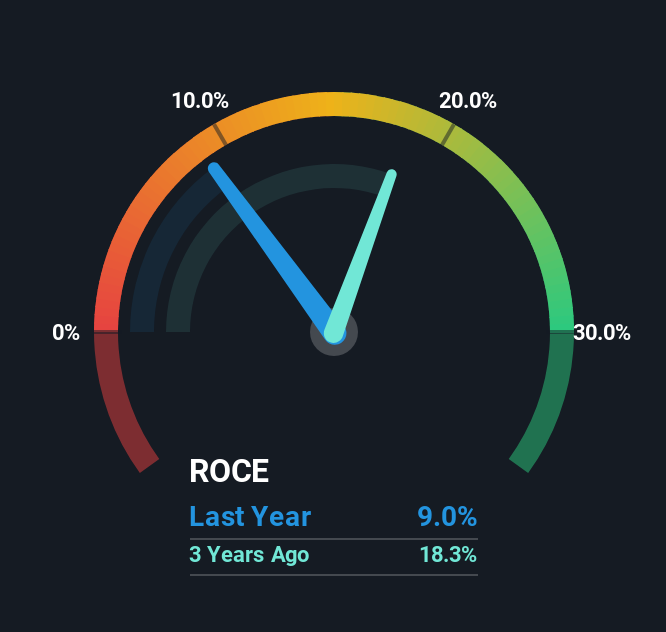- South Korea
- /
- Communications
- /
- KOSDAQ:A297570
There Are Reasons To Feel Uneasy About Aloys' (KOSDAQ:297570) Returns On Capital
If we want to find a stock that could multiply over the long term, what are the underlying trends we should look for? One common approach is to try and find a company with returns on capital employed (ROCE) that are increasing, in conjunction with a growing amount of capital employed. If you see this, it typically means it's a company with a great business model and plenty of profitable reinvestment opportunities. Although, when we looked at Aloys (KOSDAQ:297570), it didn't seem to tick all of these boxes.
Return On Capital Employed (ROCE): What Is It?
Just to clarify if you're unsure, ROCE is a metric for evaluating how much pre-tax income (in percentage terms) a company earns on the capital invested in its business. The formula for this calculation on Aloys is:
Return on Capital Employed = Earnings Before Interest and Tax (EBIT) ÷ (Total Assets - Current Liabilities)
0.09 = ₩4.4b ÷ (₩61b - ₩12b) (Based on the trailing twelve months to June 2025).
Thus, Aloys has an ROCE of 9.0%. On its own that's a low return, but compared to the average of 5.1% generated by the Communications industry, it's much better.
View our latest analysis for Aloys

While the past is not representative of the future, it can be helpful to know how a company has performed historically, which is why we have this chart above. If you're interested in investigating Aloys' past further, check out this free graph covering Aloys' past earnings, revenue and cash flow.
The Trend Of ROCE
On the surface, the trend of ROCE at Aloys doesn't inspire confidence. Over the last five years, returns on capital have decreased to 9.0% from 19% five years ago. Although, given both revenue and the amount of assets employed in the business have increased, it could suggest the company is investing in growth, and the extra capital has led to a short-term reduction in ROCE. And if the increased capital generates additional returns, the business, and thus shareholders, will benefit in the long run.
What We Can Learn From Aloys' ROCE
In summary, despite lower returns in the short term, we're encouraged to see that Aloys is reinvesting for growth and has higher sales as a result. These growth trends haven't led to growth returns though, since the stock has fallen 19% over the last five years. As a result, we'd recommend researching this stock further to uncover what other fundamentals of the business can show us.
If you want to know some of the risks facing Aloys we've found 2 warning signs (1 makes us a bit uncomfortable!) that you should be aware of before investing here.
If you want to search for solid companies with great earnings, check out this free list of companies with good balance sheets and impressive returns on equity.
New: Manage All Your Stock Portfolios in One Place
We've created the ultimate portfolio companion for stock investors, and it's free.
• Connect an unlimited number of Portfolios and see your total in one currency
• Be alerted to new Warning Signs or Risks via email or mobile
• Track the Fair Value of your stocks
Have feedback on this article? Concerned about the content? Get in touch with us directly. Alternatively, email editorial-team (at) simplywallst.com.
This article by Simply Wall St is general in nature. We provide commentary based on historical data and analyst forecasts only using an unbiased methodology and our articles are not intended to be financial advice. It does not constitute a recommendation to buy or sell any stock, and does not take account of your objectives, or your financial situation. We aim to bring you long-term focused analysis driven by fundamental data. Note that our analysis may not factor in the latest price-sensitive company announcements or qualitative material. Simply Wall St has no position in any stocks mentioned.
About KOSDAQ:A297570
Aloys
Develops, manufactures, and supplies android OTT multimedia devices in worldwide.
Excellent balance sheet with very low risk.
Market Insights
Community Narratives



